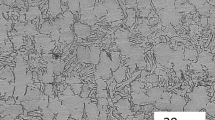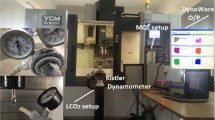Abstract
Demand for titanium alloys in different sectors is increasing in recent years due to their outstanding strength-to-weight ratio, ability to retain strength at higher temperatures and resistance to wear. Machining of titanium Ti–6Al–4V has an adverse influence from the premature failure of the tool. Conventional cooling technique fails to reduce the temperature generated at the cutting area attributed to poor surface quality. Liquid carbon dioxide (LCO2) as a cryogenic coolant has turned into a recent trend in machining as it does not require any expensive method of disposal. This experiment investigates the performance of cryogenic cooling technique in the end milling of Ti–6Al–4V using PVD-TiN-coated tool with a different speed-feed combination. The angle of the nozzle was maintained 45° in the feed direction. The results demonstrated that machining with LCO2 lowers the cutting temperature by 39.53–57.44% and surface roughness by 48.24–74.77% compared with wet machining. The impact of utilizing LCO2 as a cryogenic coolant improved the surface and subsurface characteristics.













Similar content being viewed by others
References
E.O. Ezugwu, Z.M. Wang, Titanium alloys and their machinability. J. Mater. Process. Technol. 68(3x), 262–274 (1997). https://doi.org/10.1016/S0924-0136(96)00030-1
K. Gupta, R.F. Laubscher, Sustainable machining of titanium alloys: a critical review. Proc. Inst. Mech. Eng. Part B: J. Eng. Manuf. 231(14), 2543–2560 (2017). https://doi.org/10.1177/0954405416634278
K.H. Park et al., The effect of cryogenic cooling and minimum quantity lubrication on end milling of titanium alloy Ti–6Al–4V. J. Mech. Sci. Technol. 29(12), 5121–5126 (2015). https://doi.org/10.1007/s12206-015-1110-1
I. Lee et al., Tool life improvement in cryogenic cooled milling of the preheated Ti–6Al–4 V. Int. J. Adv. Manuf. Technol. 79(1–4), 665–673 (2015). https://doi.org/10.1007/s00170-015-6849-0
J. Kouam et al., Effects of minimum quantity lubricating (MQL) conditions on machining of 7075-T6 aluminum alloy. Int. J. Adv. Manuf. Technol. 79(5–8), 1325–1334 (2015). https://doi.org/10.1007/s00170-015-6940-6
A. Shokrani, V. Dhokia, S.T. Newman, Comparative investigation on using cryogenic machining in CNC milling of Ti–6Al–4V titanium alloy. Mach. Sci. Technol. 20(3), 475–494 (2016). https://doi.org/10.1080/10910344.2016.1191953
K.A. Venugopal, S. Paul, A.B. Chattopadhya, Growth of tool wear in turning of Ti–6Al–4V alloy under cryogenic cooling. Wear 262, 1071–1078 (2007)
M. Dhananchezian, M.P. Kumar, T. Sornakumar, Cryogenic turning of AISI 304 stainless steel with modified tungsten carbide tool inserts. Mater. Manuf. Process. 26, 781–785 (2011). https://doi.org/10.1080/10426911003720821
H. Lin et al., Tool wear in Ti–6Al–4V alloy turning under oils on water cooling comparing with cryogenic air mixed with minimal quantity lubrication. Int. J. Adv. Manuf. Technol. 81(1–4), 87–101 (2015). https://doi.org/10.1007/s00170-015-7062-x
A. Khan, K. Maity, Influence of cutting speed and cooling method on the machinability of commercially pure titanium (CP-Ti) grade II. J. Manuf. Process. Soc. Manuf. Eng. 31, 650–661 (2018). https://doi.org/10.1016/j.jmapro.2017.12.021
A. Pramanik, Problems and solutions in machining of titanium alloys. Int. J. Adv. Manuf. Technol. 70(5–8), 919–928 (2014). https://doi.org/10.1007/s00170-013-5326-x
M.I. Sadik et al., Influence of coolant flow rate on tool life and wear development in cryogenic and wet milling of Ti–6Al–4V. Procedia CIRP 46, 91–94 (2016). https://doi.org/10.1016/j.procir.2016.02.014
S. Cordes, F. Hübner, T. Schaarschmidt, Next generation high performance cutting by use of carbon dioxide as cryogenics. Procedia CIRP 14, 401–405 (2014). https://doi.org/10.1016/j.procir.2014.03.091
B.D. Jerold, M.P. Kumar, Machining of AISI 316 stainless steel under carbon-di-oxide cooling. Mater. Manuf. Processes 27(10), 1059–1065 (2012). https://doi.org/10.1080/10426914.2011.654153
N.G. Patil et al., Comparative study of high speed machining of inconel 718 in dry condition and by using compressed cold carbon dioxide gas as coolant. Procedia CIRP 24(3), 86–91 (2014). https://doi.org/10.1016/j.procir.2014.08.009
O. Pereira et al., The use of hybrid CO2 + MQL in machining operations. Procedia Eng 132, 492–499 (2015). https://doi.org/10.1016/j.proeng.2015.12.524
J. Elanchezhian, M. Pradeep Kumar, Effect of nozzle angle and depth of cut on grinding titanium under cryogenic CO2. Mater. Manuf. Process. 33(13), 1466–1470 (2018). https://doi.org/10.1080/10426914.2018.1453151
S. Ravi, M.P. Kumar, Experimental investigations on cryogenic cooling by liquid nitrogen in the end milling of hardened steel. Cryogenics 51(92), 509–515 (2011). https://doi.org/10.1016/j.cryogenics.2011.06.006
Y. Kaynak, Evaluation of machining performance in cryogenic machining of Inconel 718 and comparison with dry and MQL machining. Int. J. Adv. Manuf. Technol. 72(5–8), 919–933 (2014). https://doi.org/10.1007/s00170-014-5683-0
K. Nimel Sworna Ross, G. Manimaran, Effect of cryogenic coolant on machinability of difficult-to-machine Ni–Cr alloy using PVD-TiAlN coated WC tool. J. Brazilian Soc. Mech. Sci. Eng. 41, 1–14 (2019). https://doi.org/10.1007/s40430-018-1552-3.
P. Sivaiah, D. Chakradhar, Comparative evaluations of machining performance during turning of 17-4 PH stainless steel under cryogenic and wet machining conditions. Mach. Sci. Technol. 22(1), 147–162 (2018). https://doi.org/10.1080/10910344.2017.1337129
O.N. Celik et al., Effect of cryogenic treatment on the microstructure and the wear behavior of WC-Co end mills for machining of Ti6Al4V titanium alloy. Int. J. Adv. Manuf. Technol. 95(5–8), 2989–2999 (2018). https://doi.org/10.1007/s00170-017-1444-1
Author information
Authors and Affiliations
Corresponding author
Additional information
Publisher's Note
Springer Nature remains neutral with regard to jurisdictional claims in published maps and institutional affiliations.
Rights and permissions
About this article
Cite this article
Nimel Sworna Ross, K., Ganesh, M. Performance Analysis of Machining Ti–6Al–4V Under Cryogenic CO2 Using PVD-TiN Coated Tool. J Fail. Anal. and Preven. 19, 821–831 (2019). https://doi.org/10.1007/s11668-019-00667-1
Received:
Published:
Issue Date:
DOI: https://doi.org/10.1007/s11668-019-00667-1




